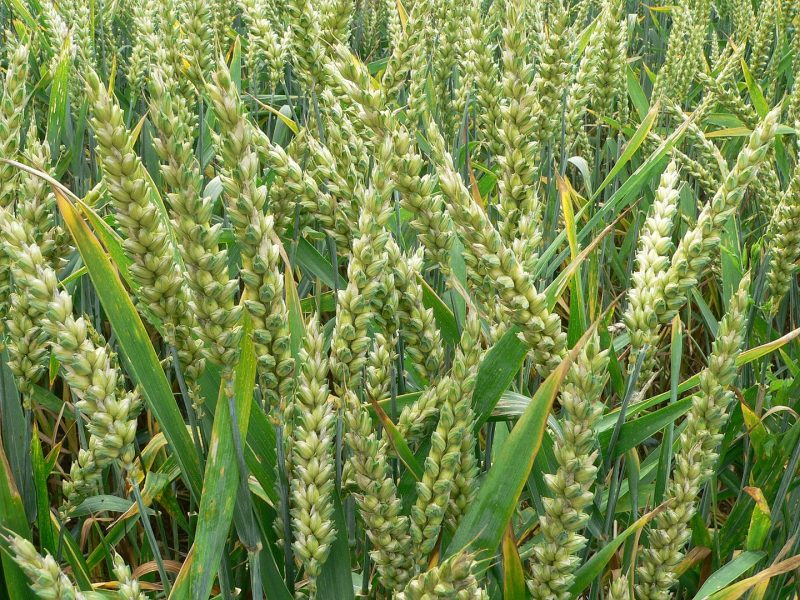
Wheat crop hit by untimely rains and hailstorm, 5.23 lakh hectare affected

Farmers in three states are facing the possibility of substantial yield loss and harvesting difficulties as a result of untimely rains, hailstorms, and strong winds impacting over 5.23 lakh hectares of wheat crops.
India is one of the major producers of wheat, a key staple for a significant population, and the crop damage scenario also comes against the backdrop of persisting high inflation and food security woes globally amid geopolitical uncertainties.
Also Read: Cheetah Oban sneaks out of Kuno, strays into MP village 20 km away
Around 5.23 lakh hectare of wheat crop is estimated to have been damaged in three states — Madhya Pradesh, Rajasthan and Uttar Pradesh — due to the inclement weather, according to officials.
The assessment of wheat crop damage in Punjab and Haryana is underway, they said.
This year, the wheat sown area is around 34 million hectares. The government is estimating a record 112.2 million tonne wheat output in the ongoing 2022-23 crop year (July-June), the officials said.
Union Agriculture Secretary Manoj Ahuja told PTI the government on Monday will review along with state governments the extent of damage caused to wheat and other rabi crops because of the fresh spell of untimely rains received in the last two to three days.
Wheat is a major rabi (winter) crop. Rains have come at a time when the crop was almost ready for harvesting. In some parts of Madhya Pradesh, the government procurement at minimum support price has begun.
Also Read: Rahul appeals in sessions court against ‘Modi surname’ case verdict: Reports
Since the last two weeks, major wheat growing states of Punjab, Haryana, Uttar Pradesh and Madhya Pradesh have received unseasonal rains accompanied by thunderstorm, hailstorm and gusty wind due to the western disturbances. The untimely rains are expected to continue for a few more days.
There is a heavy loss to the wheat crop because of the inclement weather. Against an average yield of 20 quintals per acre, this time it will drop to 10-11 quintals an acre,” worried grower Bhupinder Singh from village Badarpur in Punjab’s Mohali district, told PTI.
Singh, who has grown the winter crop over 34-acre of land in Badarpur, said at some places in his fields, the crop has also flattened because of high-velocity winds.
There will be an average 50 per cent yield loss in wheat crop because of untimely rains and high-velocity winds, he said and added, “If rain continues for more days, the crop will completely submerge in it.”
Also Read: Stalin’s conference to see congregation of Opposition leaders in Delhi on April 3
Another farmer from Madhya Pradesh, Ajay Singh — who owns two acres of land in Khajuraho — said, “We are noticing fungal disease in the wheat crop due to high moisture. The quality of grain will be affected.”
The total area of wheat cultivation in Madhya Pradesh is 95 lakh hectares, out of which “nearly one lakh hectare” has got affected in the recent rain and hailstorm, said a senior official of the Madhya Pradesh agriculture department.
“The crop loss is not much and even in the affected areas the lustre on the harvest is little bit affected,” the official added.
In Rajasthan too, about 3.88 lakh hectare of wheat crop out of total sown area of 29.65 lakh hectare has been impacted due to the untimely rainfall, said official sources.
Also Read: Bihar violence: 1 dead, 6 injured; Centre beefs up security ahead of Shah’s rally
Besides wheat, mustard, channa, barley and other vegetable crops have been impacted in Rajasthan. About 1.54 lakh hectare and 1.29 lakh hectare of mustard and channa crops, respectively, have been damaged due to rains in the state, the sources added.
Similarly in Uttar Pradesh, over 35,000 hectare of wheat crop has been damaged by the recent untimely rains, according to the information provided by the office of Relief Commissioner of Uttar Pradesh,
Most of the damage has been reported from nine districts of the state including Agra, Bareilly, Chandauli, Hamirpur, Jhansi, Lalitpur, Prayagraj, Unnao and Varanasi.
“An estimated 1.25 lakh wheat farmers have been affected by the rains. The data regarding the losses and damages is being recorded. So far information about 43,142 of these farmers have been logged into our system,” UP relief Commissioner Prabhu N Singh said.
The affected farmers will be provided relief by the government once the data is collected, he added.
Also Read: Why Rahul’s disqualification comes as a dampener for Nitish’s PM dreams
Meanwhile, Punjab Chief Minister Bhagwant Mann and Haryana Agriculture minister J P Dalal have directed the officials concerned to carry out special girdawari to assess the crop loss.
According to Indian Agricultural Research Institute (IARI) scientist and wheat breeder Rajbir Yadav, “In hailstorm-hit areas, the wheat crop loss is certain. The extent of damage can only be ascertained when farmers get their produce to mandis.”
In some places, unseasonal rains have caused lodging in wheat crops due to which standing crop falls. However, it is difficult to quantify the extent of damage, it can reduce the quality of the grain and may lead to harvesting losses, he said.
In such a situation, the farmers would face challenges in harvesting as it is difficult to pick up the fallen wheat crop by a combine harvester, while manual harvesting is labour intensive and costly, he added.
Also Read: Karnataka elections: The curious case of BSY’s son and Varuna seat
Meanwhile, some state governments have taken steps to provide relief to farmers. For instance, the Punjab government had last week announced a 25 per cent hike in the compensation for crop loss due to vagaries of weather.
Haryana Chief Minister M L Khattar had said the farmers can register the crop loss on the e-Fasal Kshatipurti portal and the compensation will be provided to all the farmers by the month of May.


